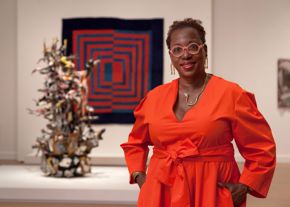Close-Up on “Black Art & Abstraction” July 29, 2020

Valerie Cassel Oliver, curator of modern and contemporary art, the Virginia Museum of Fine Arts.
Photo: Travis Fullerton, courtesy the Virginia Museum of Fine Arts
Soul of a Nation: Art in the Age of Black Power
Installation view of Soul of a Nation: Art in the Age of Black Power.
Valerie Cassel Oliver moderates “Black Art & Abstraction” on Saturday, August 1, at 3 p.m. The third of five livestream panel discussions accompanying Soul of a Nation: Art in the Age of Black Power, this conversation features three artists whose work is included in the exhibition: Melvin Edwards, Fred Eversley, and William T. Williams. Cassel Oliver, curator of modern and contemporary art at the Virginia Museum of Fine Arts, was senior curator at the Contemporary Arts Museum Houston until 2017.
Here, she answers a few questions about Black artists working in abstraction during the decades covered by the exhibition.
What challenges—artistic and otherwise—faced Black artists working in abstraction in the 1960s, 1970s, and early 1980s?
In understanding the political and social climate of the 1960s and 1970s, the visual language of abstraction for many felt antithetical to the moment. Political leaders called upon artists to align themselves with the movement with “positive” and “uplifting” art that served to reflect community. That “reflection” for many would be understood as a literal reflection—embracing artists working figuratively, while pushing aside those working in abstraction, a visual language that felt fractured and obscure to the masses.
One of the exhibition’s key themes is what it meant to be a Black artist in America during that time. How does the work of abstract artists speak to that?
Those artists working in abstraction underscore that artists have always sought out the edges. There is no such thing as a monolith, but rather a collective of diverse voices who seek to unveil the “soul of a nation,” the soul of community, shared experiences and a shared ethos. Artists featured in this exhibition, as well as those who have emerged in the wake of the late 1960s and 1970s, have engaged in an ongoing and ever-evolving conversation about what it means to be Black in America, and what Black artists should be creating, and what Black art should look like. The range and innovation featured within the exhibition points to evidence of a shared sensibility, as well as a diverse and expansive range of expression.
How would you characterize the varying approaches to abstraction, as represented in the exhibition?
Strategies in abstraction take many forms: dissolution of landscape, or the fractured landscape; the ethereal state of being—emotional or spiritual; the dynamism of color, the rhythmic and mystical nature of patterning; the language and symbolism of color; the unabashed freedom of mark-making; and the drama of restraint through minimalist gesture.
► Learn more about the artists on the panel.
► Join the virtual discussion on Saturday, August 1, at 3 p.m. Before or after, experience Soul of a Nation: Art in the Age of Black Power at the MFAH, the final venue for the exhibition’s three-year tour. Plan ahead for your visit.
This virtual lecture series receives generous funding from Humanities Texas, the state affiliate of the National Endowment for the Humanities.





